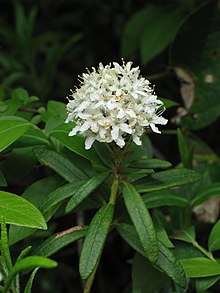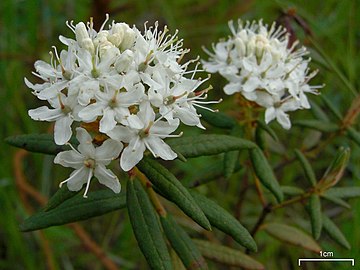-
Illustration by William Miller
-
Specimen in Newfoundland and Labrador
-
Dry leaves
-
Underside of leaves
-
Leaves and buds
-
Close-up of flowers
| Rhododendron groenlandicum | |
|---|---|

| |
|
Scientific classification
| |
| Kingdom: | Plantae |
| Clade: | Tracheophytes |
| Clade: | Angiosperms |
| Clade: | Eudicots |
| Clade: | Asterids |
| Order: | Ericales |
| Family: | Ericaceae |
| Genus: | Rhododendron |
| Subgenus: | Rhododendron subg. Rhododendron |
| Section: | Rhododendron sect. Rhododendron |
| Subsection: | R. subsect. Ledum |
| Species: | R. groenlandicum
|
| Binomial name | |
| Rhododendron groenlandicum | |

| |
| Distribution of Rhododendrom groenlandicum | |
| Synonyms [1] | |
| |
Rhododendron groenlandicum (bog Labrador tea, muskeg tea, swamp tea, or in northern Canada, Hudson's Bay tea; [2] formerly Ledum groenlandicum or Ledum latifolium) [3] is a flowering shrub with white flowers and evergreen leaves that is used to make a herbal tea.
Description
It is a low shrub growing to 50 centimetres (20 inches) tall—rarely up to 2 metres (6+1⁄2 feet)—with evergreen leaves 2–6 cm (3⁄4–2+3⁄8 in) long and 3–15 millimetres (1⁄8–5⁄8 in) broad. The leaves are wrinkled on top, densely hairy white to red-brown underneath, and have a leathery texture, curling at the edges. The tiny white flowers grow in hemispherical clusters and are very fragrant and sticky. [4]
Distribution and habitat
It is reported from Greenland, as well as from every province and territory in Canada and in the north of the United States including the Northeast ( New England, New York, Pennsylvania), the Northwest ( Oregon, Washington, Idaho), parts of the Upper Midwest ( Michigan, Wisconsin, Minnesota) and Alaska. [5]
It grows in bogs, muskegs, and open tundra, as well as occasionally on wet shores and rocky alpine slopes. [6] [7]
Toxicity
The plant contains toxic alkaloids which are poisonous to livestock and may be toxic to humans in concentrated doses. [7]
Uses
The leaves are regularly used to make beverages and medicines—most commonly a fragrant tea—by many Native American tribes such as the Quinault and Makah, the Potawatomi, the Anishinaabe, the Iroquois, and First Nations tribes in Canada. [7] When European explorers arrived, they soon adopted these uses as well, dubbing it "Indian plant tea". [7] During the American Revolutionary War, it was used as a substitute for tea. [7]
It is sometimes grown as an ornamental shrub. [7]
Its essential oil is popular in aromatherapy. [7]
See also
- Rhododendron (disambiguation)
- List of Rhododendron species
- List of rhododendron diseases
- List of Award of Garden Merit rhododendrons
References
- ^ "Rhododendron groenlandicum". Plants of the World Online. Royal Botanic Gardens, Kew. Retrieved 27 March 2022.
- ^ Niering, William A.; Olmstead, Nancy C. (1985) [1979]. The Audubon Society Field Guide to North American Wildflowers, Eastern Region. Knopf. p. 502. ISBN 0-394-50432-1.
- ^ Kron, Kathleen Anne; Judd (1990). "Phylogenetic Relationships within the Rhodoreae (Ericaceae) with Specific Comments on the Placement of Ledum". Systematic Botany. 15 (1): 67. doi: 10.2307/2419016. JSTOR 2419016.
- ^ Peterson, R. T. and McKenny, M. A Field Guide to Wildflowers Northeastern and North-central North America.
- ^ "Rhododendron groenlandicum". Plants of the World Online. Royal Botanic Gardens, Kew. Retrieved 27 March 2022.
- ^ Kron, Kathleen A.; Judd, Walter S. (1990). "Rhododendron groenlandicum". Systematic Botany. 15 (1). Flora of North America: 57–68. doi: 10.2307/2419016. JSTOR 2419016.
- ^ a b c d e f g Anderson, M. (2011). Plant Guide for bog Labrador tea (Ledum groenlandicum) (PDF). Greensboro, NC.: USDA-Natural Resources Conservation Service, National Plant Data Team.
External links
| Rhododendron groenlandicum | |
|---|---|

| |
|
Scientific classification
| |
| Kingdom: | Plantae |
| Clade: | Tracheophytes |
| Clade: | Angiosperms |
| Clade: | Eudicots |
| Clade: | Asterids |
| Order: | Ericales |
| Family: | Ericaceae |
| Genus: | Rhododendron |
| Subgenus: | Rhododendron subg. Rhododendron |
| Section: | Rhododendron sect. Rhododendron |
| Subsection: | R. subsect. Ledum |
| Species: | R. groenlandicum
|
| Binomial name | |
| Rhododendron groenlandicum | |

| |
| Distribution of Rhododendrom groenlandicum | |
| Synonyms [1] | |
| |
Rhododendron groenlandicum (bog Labrador tea, muskeg tea, swamp tea, or in northern Canada, Hudson's Bay tea; [2] formerly Ledum groenlandicum or Ledum latifolium) [3] is a flowering shrub with white flowers and evergreen leaves that is used to make a herbal tea.
Description
It is a low shrub growing to 50 centimetres (20 inches) tall—rarely up to 2 metres (6+1⁄2 feet)—with evergreen leaves 2–6 cm (3⁄4–2+3⁄8 in) long and 3–15 millimetres (1⁄8–5⁄8 in) broad. The leaves are wrinkled on top, densely hairy white to red-brown underneath, and have a leathery texture, curling at the edges. The tiny white flowers grow in hemispherical clusters and are very fragrant and sticky. [4]
-
Illustration by William Miller
-
Specimen in Newfoundland and Labrador
-
Dry leaves
-
Underside of leaves
-
Leaves and buds
-
Close-up of flowers
Distribution and habitat
It is reported from Greenland, as well as from every province and territory in Canada and in the north of the United States including the Northeast ( New England, New York, Pennsylvania), the Northwest ( Oregon, Washington, Idaho), parts of the Upper Midwest ( Michigan, Wisconsin, Minnesota) and Alaska. [5]
It grows in bogs, muskegs, and open tundra, as well as occasionally on wet shores and rocky alpine slopes. [6] [7]
Toxicity
The plant contains toxic alkaloids which are poisonous to livestock and may be toxic to humans in concentrated doses. [7]
Uses
The leaves are regularly used to make beverages and medicines—most commonly a fragrant tea—by many Native American tribes such as the Quinault and Makah, the Potawatomi, the Anishinaabe, the Iroquois, and First Nations tribes in Canada. [7] When European explorers arrived, they soon adopted these uses as well, dubbing it "Indian plant tea". [7] During the American Revolutionary War, it was used as a substitute for tea. [7]
It is sometimes grown as an ornamental shrub. [7]
Its essential oil is popular in aromatherapy. [7]
See also
- Rhododendron (disambiguation)
- List of Rhododendron species
- List of rhododendron diseases
- List of Award of Garden Merit rhododendrons
References
- ^ "Rhododendron groenlandicum". Plants of the World Online. Royal Botanic Gardens, Kew. Retrieved 27 March 2022.
- ^ Niering, William A.; Olmstead, Nancy C. (1985) [1979]. The Audubon Society Field Guide to North American Wildflowers, Eastern Region. Knopf. p. 502. ISBN 0-394-50432-1.
- ^ Kron, Kathleen Anne; Judd (1990). "Phylogenetic Relationships within the Rhodoreae (Ericaceae) with Specific Comments on the Placement of Ledum". Systematic Botany. 15 (1): 67. doi: 10.2307/2419016. JSTOR 2419016.
- ^ Peterson, R. T. and McKenny, M. A Field Guide to Wildflowers Northeastern and North-central North America.
- ^ "Rhododendron groenlandicum". Plants of the World Online. Royal Botanic Gardens, Kew. Retrieved 27 March 2022.
- ^ Kron, Kathleen A.; Judd, Walter S. (1990). "Rhododendron groenlandicum". Systematic Botany. 15 (1). Flora of North America: 57–68. doi: 10.2307/2419016. JSTOR 2419016.
- ^ a b c d e f g Anderson, M. (2011). Plant Guide for bog Labrador tea (Ledum groenlandicum) (PDF). Greensboro, NC.: USDA-Natural Resources Conservation Service, National Plant Data Team.





